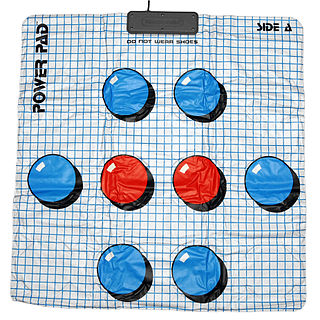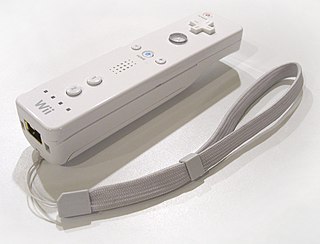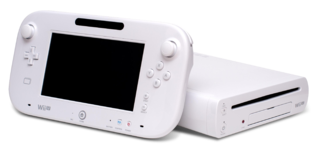
A game controller, gaming controller, or simply controller, is an input device used with video games or entertainment systems to provide input to a video game, typically to control an object or character in the game. Before the seventh generation of video game consoles, plugging in a controller into one of a console's controller ports was the primary means of using a game controller, although since then they have been replaced by wireless controllers, which do not require controller ports on the console but are battery-powered. USB game controllers could also be connected to a computer with a USB port. Input devices that have been classified as game controllers include keyboards, mouses, gamepads, joysticks, etc. Special purpose devices, such as steering wheels for driving games and light guns for shooting games, are also game controllers.

The Power Pad is a floor mat game controller for the Nintendo Entertainment System. It is a gray mat with twelve pressure-sensors embedded between two layers of flexible plastic. It was originally developed by Bandai.

The Wii is a home video game console developed and marketed by Nintendo. It was released on November 19, 2006, in North America and in December 2006 for most other regions of the world. It is Nintendo's fifth major home game console, following the GameCube and is a seventh generation home console alongside Microsoft's Xbox 360 and Sony's PlayStation 3.

A gamepad is a type of game controller held in two hands, where the fingers are used to provide input. They are typically the main input device for video game consoles.

The Wii Remote, also known colloquially as the Wiimote, is the primary game controller for Nintendo's Wii home video game console. An essential capability of the Wii Remote is its motion sensing capability, which allows the user to interact with and manipulate items on screen via gesture recognition and pointing which is used for the console, using accelerometer and optical sensor technology. It is expandable by adding attachments. The attachment bundled with the Wii console is the Nunchuk, which complements the Wii Remote by providing functions similar to those in gamepad controllers. Some other attachments include the Classic Controller, Wii Zapper, and the Wii Wheel, originally used for the racing game Mario Kart Wii.

The Wii Zapper is a gun shell peripheral for the Wii Remote. The name is a reference to and successor of the NES Zapper light gun for the Nintendo Entertainment System. It is mainly used to enhance controls for shooter games, including light gun shooters, first-person shooters, and third-person shooters.

The Classic Controller is a game controller produced by Nintendo for the Wii video game console. While it later featured some compatibility with the Wii U console, the controller was ultimately succeeded by the Wii U Pro Controller. In April 2014, Nintendo discontinued production of both the Classic Controller and Classic Controller Pro.
Nyko is an American manufacturer of third-party accessories for various gaming consoles.

In video games and entertainment systems, a motion controller is a type of game controller that uses accelerometers or other sensors to track motion and provide input.

The GameCube controller is the standard game controller for the GameCube home video game console, manufactured by Nintendo and launched in 2001. As the successor to the Nintendo 64 controller, it is the progression of Nintendo's controller design in numerous ways. The contentious M-shaped design of its predecessor was replaced with a more conventional handlebar style controller shape; a second analog stick was added, replacing the C buttons with a C stick and the X and Y face buttons, last seen on the Super Nintendo controller, were reintroduced; the shoulder buttons were changed to hybrid analog triggers. A wireless variant of the GameCube controller known as the WaveBird was released in 2002.

The Japanese multinational consumer electronics company Nintendo has developed seven home video game consoles and multiple portable consoles for use with external media, as well as dedicated consoles and other hardware for their consoles. As of September 30, 2021, in addition to Nintendo Switch, Nintendo has sold over 863.07 million hardware units.

The Wii MotionPlus (Wiiモーションプラス) is an expansion device for the Wii Remote, the primary game controller for the Wii. The device allows more complex motion to be interpreted than the Wii Remote can do alone. Both the Wii and its successor, the Wii U, support the Wii MotionPlus accessory in games.

The Nyko Kama is a third-party Nunchuk accessory created for the Wii video game console by Nyko, available in wireless or wired versions. In contrast to Nintendo's device, the controller takes its name from the traditional Japanese kama; a stealthy, curved weapon. Like the original Nunchuk, the Kama features an analog control stick, and "Z" and "C" buttons. With the use of 2 AAA batteries and an adapter dongle that plugs into the Wii Remote's expansion port, the wireless Kama is able to connect wirelessly. The wired version instead features a rumble motor, which allows it to offer force feedback when used with Nyko's Wand Wii Remote alternative.

PlayStation Move is a motion game controller developed by Sony Computer Entertainment. Initially released in 2010 for use with the PlayStation 3 video game console, its compatibility was later expanded to its successor, the PlayStation 4 in 2013, its PlayStation VR platform in 2016 and the PlayStation 5 in 2020. Conceptually similar to Nintendo's Wii Remote and Microsoft's Kinect, its function is based around controller input in games stemming from the actual physical movement of the player. The Move uses inertial sensors in the wand to detect motion while the wand's position is tracked using a PlayStation Eye or PlayStation Camera. The device was generally well received by critics, but has not quite met Sony's goals for integration into the market.
Since the release of Nintendo's Wii, many aesthetic, ergonomic and functional accessories have been developed for the Wii Remote by third parties.

The Wii U is a home video game console developed by Nintendo as the successor to the Wii. Released in late 2012, it is the first eighth-generation video game console and competed with Microsoft's Xbox One and Sony's PlayStation 4.
Rhythm game accessories are often required to play rhythm games available for various consoles, such as the PlayStation 2, PlayStation 3, Wii, and Xbox 360. These include dance pads, guitar controllers, drum controllers, microphones and turntable controllers. With the exception of microphones, these controllers can generally be used to control any game, but have limited inputs, making them impractical for most games.

Joy-Con are the primary game controllers for the Nintendo Switch video game console. They consist of two individual units, each containing an analog stick and an array of buttons. They can be used while attached to the main Nintendo Switch console unit, or detached and used wirelessly; when detached, a pair of Joy-Con can be used by a single player, or divided between two as individual controllers. The controllers have been criticized for the tendency of the analog sticks to register inputs when not being touched.
















